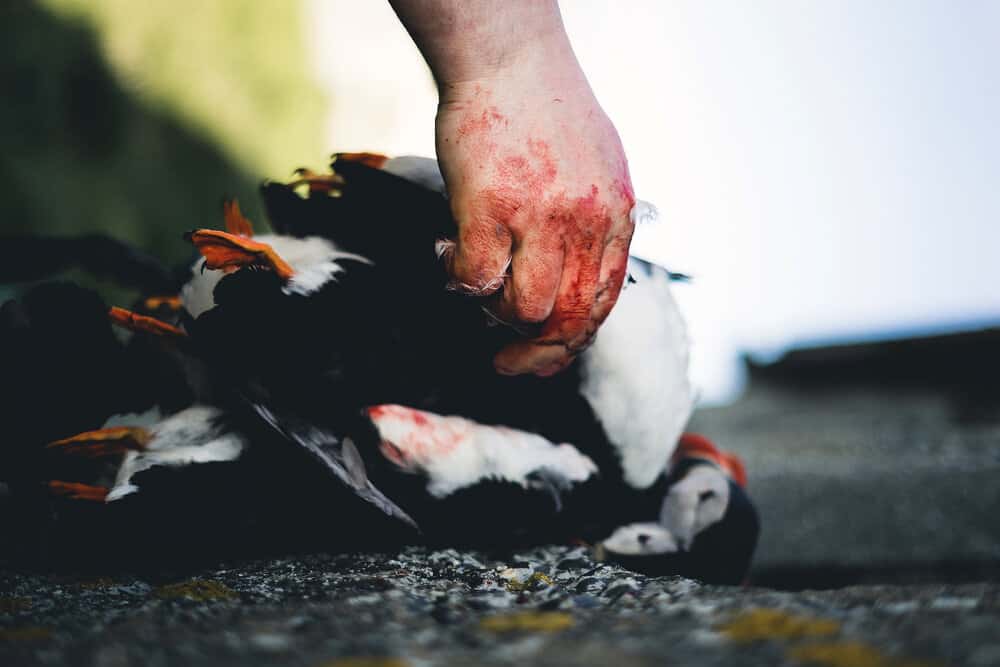Your cart is empty
STORY BY Gunnar Guðmundsson
ICELAND | SKRÚÐUR
As I face into an eastern breeze, a fine spray of sea water causes me to squint through the droplets. I watch, transfixed at the white band across the pectoral fin of a minke whale. As we cut gentle waves in our Zodiac, the first of many northern gannets circle the boat above us, before tailing our wake. This procession follows us in increasing numbers, seemingly pleased that we ventured to their remarkable home — the isle of Skrúður.
I embarked on this adventure with my good friend, hunter and photographer Robert Cabrera, accompanied by Óðinn Logi, a seasoned puffin hunter and East Coast native. We’ve been circling the island, soaking in place names, legends, and hunting stories from Óðinn’s youth. At a young age he became a full-time puffin hunter during the summer months, learning the ropes from his relatives. Like them, he would become a guardian of the island.The breath-taking scenery is more than we expected, and while writing down these memoirs, I struggle to give it the justice it deserves.
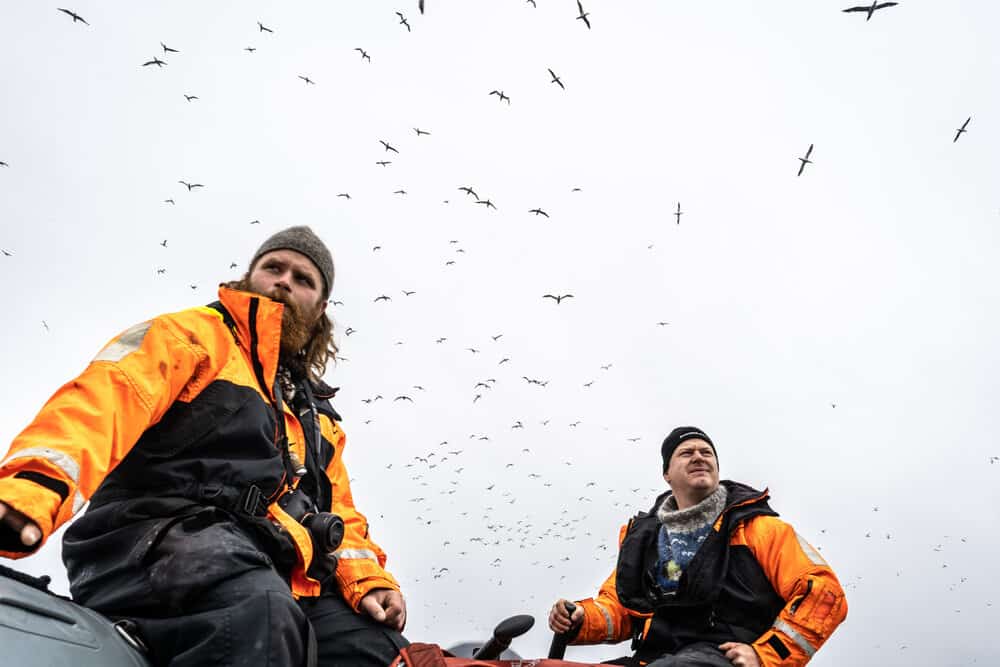
Diving puffins, guillemot, cormorants, and harbor seals watch our every move. Their intrigue is more of curiosity than fear, implying that the sight of humans is quotidian in their world. Óðinn claims that since the settlement of Iceland in 872 CE, less than 1,000 people have stepped foot on the island, a claim I have no reason to second guess.
The strong currents around the narrow cove we intend to anchor in soak up every ounce of horsepower the Zodiac’s motor can provide as we ride the waves, with bare, exposed rocks on both sides, beaten and weathered by centuries of rough seas.
Once secured in the calm of the inlet, we unload the equipment from the boat, ferrying the tools in a human chain over steep, slippery, and nasty rocks covered in seaweed. As we work, Óðinn continues telling us about the folklore of this place.
“The legend says that the island Skrúður is inhabited and guarded by a mythical being: The farmer of Skrúður. He acquired a distinctive taste for full-curled rams from herds of sheep roaming the island during the summer months. Historically the islands around Iceland had been used as summer sheep pasture for farmers with limited land resources, providing herds with grazing in the summer months, before being brought back to the mainland in winter months.”
The landscape of the island — steep hills, narrow paths, and vertical drops — is most likely the explanation for the noticeable rate of death among these rams, rather than the farmer’s penchant for eating sheep. However, it isn’t only the livestock that the farmer of Skrúður seemed to have his eye on.
“Allegedly, the farmer also abducted a priest’s daughter from a nearby fjord and forced her to live with him on the island. Once he had obtained his bride, they disappeared into a giant cave, which was later covered by a landslide. After that, the newlyweds were never to be seen again.”
“If you don’t believe this story,” Óðinn continues, “You must dig the landslide up to prove me wrong”.
Up the narrow path, we continue onward, overwatched by puffins within arm’s reach. Just like those who came before us, we tread step-by-step into the unknown, keeping our focus firmly on the trail — one misstep could be our last.

High up, within a rock formation that looks like an avocado cut in half with the stone removed, lies our base camp. The island’s 5-star hotel. Built in the ’80s by Óðinn’s relatives and used during the puffin season, it would surely be a welcome sight after a long day hunting on the cliffs.
We leave our gear and pack the essentials into camp before we head over to the opposite side of the island. The sun is up, and as we ascend further, I get a feel for how abundant puffins are on the island; we can’t seem to take a step without falling into a puffin hole. The warm weather, green hills, extraordinary wildlife, and surroundings make me realize that the nickname “The Galapagos of the north” is a justified comparison.
Once on the other side, we are amazed by the spectacle that greets us; thousands of puffins fly by for as long as we stand watching. There seems to be no end to the flow of these majestic birds.
We follow Óðinn downhill as he reads the wind and picks our first ‘high seat’ for the day. He sits down and directly gets into it. Within minutes, he effortlessly catches the first three birds of the day, demonstrating his unique skill-set, honed and perfected over the years.
Harsher weather, limited biodiversity, and overall rougher conditions compared to most other places on Earth called for hardy, fierce inhabitants. After the settlement by Viking explorers in 870 CE, the settlers quickly had to learn how to survive and live off this new land. Despite resources being less plentiful than in mainland Scandinavia, they were able to rely on skills well-known to them: fishing, hunting, and gathering. Building materials were hard to find, and rocks were used instead of timber for building shelters.
Historically, Icelanders had to make the most of each season, with food resources limited throughout much of the year. They planted crops, kept livestock and harvesed nature’s bounty. Every element was essential if they were to survive. Each part of Iceland offered different opportunities and resources, which people could reap the benefits of. If done with care, they would be available year after year. Guillemot colonies provided one important food source — thousands of eggs could be sustainably taken each year, along with the large numbers of birds. I know for a fact that those who harvested birds from Látrabjarg felt they weren’t prepared for winter unless they could eat a bird each day. One bird for a grown man, half a bird for a woman, and the other half for a child.
We Icelanders are very proud of our ancestral heritage — a hardened people forged from severe conditions where only the strong survived. Although we can by no means compare modern-day society or modern Icelanders to our forefathers, we still hold on tight to some of their traditions. Traditions that unite us. Traditions that make us genuine Icelanders.
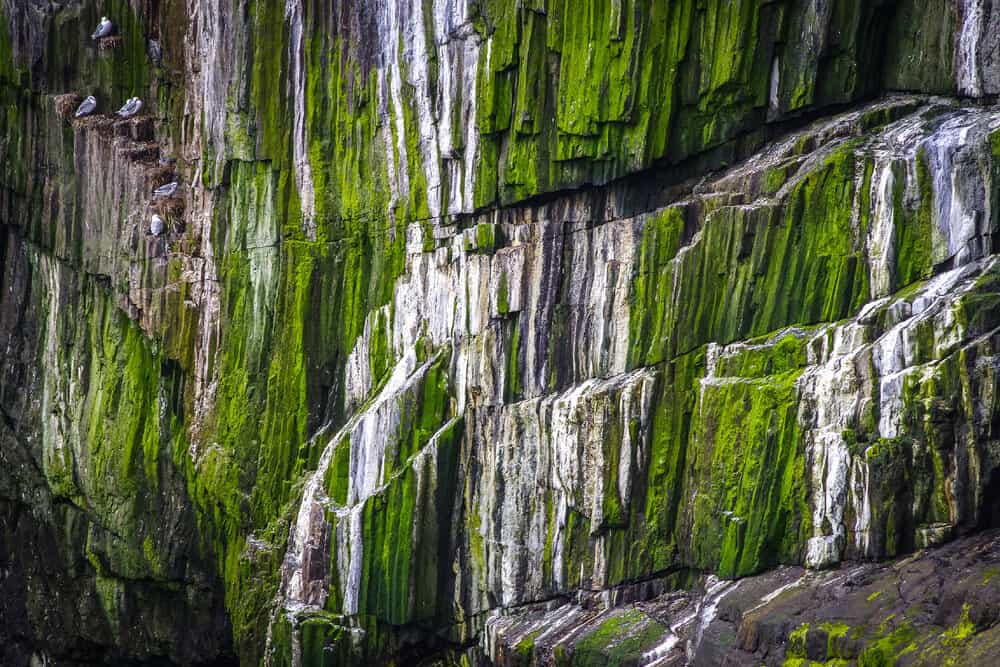
Everywhere you look in human history, you’ll find varying cuisines or food traditions determined by the landscape and culture, evolving around resources. Some might be unappealing, some might be delicious, and some might be ethically unacceptable in modern society. What these traditional foods all have in common is that they are regional, seasonal, and usually descended from methods of storing food. The same ideology goes for the method of take. Humans have always figured out a way to feed themselves and their own. Those who did not fell off the train through natural selection.
From stones and traps to spears and snares, bows and arrows to modern-day weapon systems, all these tools were functional for their time in history, and they all made up for our lack of natural weaponry. The opposable thumb and our brains —”the crowning achievement of evolution” — made it possible for us to make and use these tools. With these, we became more efficient hunters.
Using a net to hunt puffins is a technique we Icelanders learned and adapted from our relatives in the Faroe Islands in the mid-1800s. It was more efficient and ethical than the methods used previously.
Today, netting puffins is a shadow of the past, a tradition practiced by only a few and under strict regulations. Hunting is only permitted on a small number of islands now, and only for a short period, often with a bag limit imposed. Yet, netting and eating puffins plays a significant role in the islanders’ traditions. Not only are they one of the best-tasting seabirds, they also bind us to those who came before, a reciprocal link in the chain that connects us to our ancestors. By honoring their traditions and making them our own, we honor them. As I immerse myself in the experience now upon me, it is as if my ancestors are passing the torch, and I feel the weight of this burden.
Although an experienced hunter like Óðinn makes the act of netting a puffin look relaxed and natural, I quickly find out that looks can be deceiving. In his own words, the formula goes like this: “You wait for the right amount of wind. The puffins circle the hills when the wind is blowing perfectly. Too much wind, and they won’t fly. Too little wind, and they won’t fly.” When asked what he considers to be the perfect amount of wind, he replies, “When the puffins are flying.” He goes on to explain the necessary tools of the trade to me.
“The net itself needs to have two metal or wooden spikes with a V-form attached to a three- to four-meter-long long pole. The netting is attached between the spikes. The V-form is important, because a full-circle, like regular fly-fishing nets, will scare the puffins away from the swinging net.
“You place yourself in the hills in front of boulders or cracks, so your silhouette blends in with the background. Then, you wait for the right moment. When a flying puffin comes within reach, you kick the pole off your thigh and raise the net in front of the puffin, catching him into the V-formed part of the net.
“With a puffin in the net, you need to work quickly, and simultaneously reel the pole in as you’re lowering the net in the same direction it was flying. Then you release him from the net, keeping an eye out for his beak — they tend to bite quite hard. Quickly snap his neck, and get ready for the next one. In good conditions, an experienced hunter can net over a hundred puffins in an hour.”
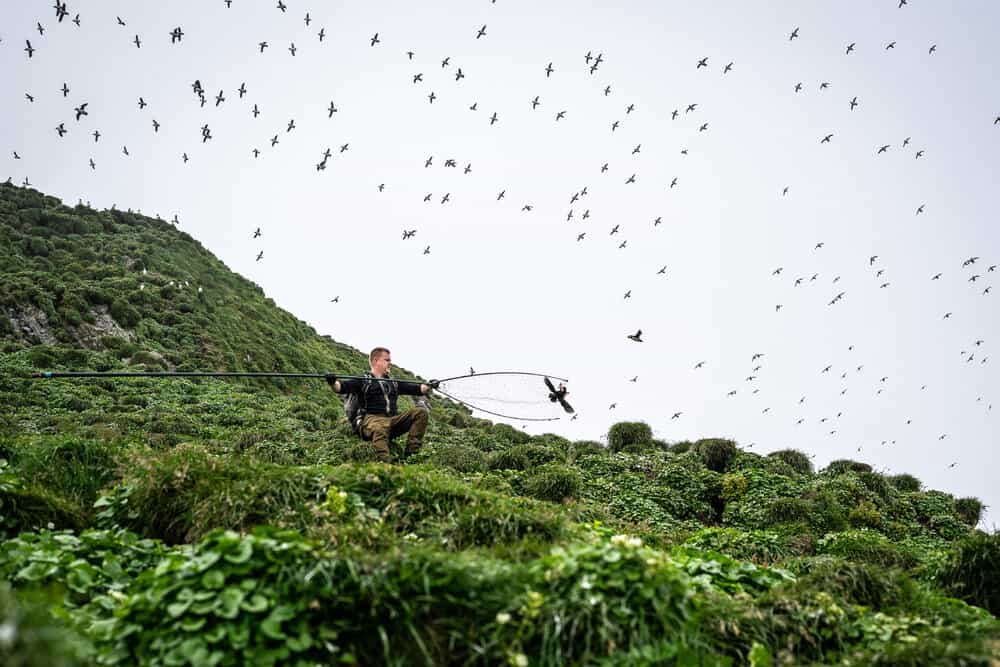
With the bar raised high, I aim for immediate success. As a former national team hockey player specializing in redirecting pucks into the net, I am confident the hand-to-eye coordination I’ve developed over years of training will give me an unexpected advantage.
I take a seat, imagining I’m back in front of the net during a playoff game, as the D-man throws me a gentle wrist shot, cutting between the crowded high slot. I’m blocking the goalie, and there is nothing left to do but tap the puck into the net. The puffin lines up perfectly. I raise the net. It’s a swing and a miss. Nothing else to do but to try again, and again, and again. After dozens of failed attempts, I step back. Netting puffins certainly isn’t as easy as it looks. Patience is key, and after some time, I begin to get the hang of it, although I certainly wouldn’t qualify as a commercial puffin hunter just yet.
The wind settles down, and the notorious east fjords fog slowly moves in. We decide to continue our journey toward the gannet colony in the north of the island. We tie our catch together and wrap them around our necks, just as the puffin hunters of old always did. Óðinn jokes about the small, parasitic sea-bird’s tick, which will inevitably vacate the cooling bodies of the deceased puffins in search of warmer climes. He insists that a few bites will only toughen us up, and that having a beer or two in your system will make us immune. I read from the grin on his face, though, that I should probably leave it up to others to put his theory to test.
Once we make it over to the Northern gannet colony, our jaws drop for the third time that day. Thousands if not hundreds of thousands of individuals roam the bare rocky hillside, from hatching eggs to feathered chicks and everything in between. Although young gannet chicks are also harvested from the colony, dispatched with wooden clubs, we have enough puffins to bring home to our families, so we spent the afternoon filling memory cards rather than our freezers. Heading back to camp, we serve up a Nordic cuisine dish fit for any Michelin restaurant: grilled puffin breasts with scurvy-grass, dried fish, and butter. After all, we’re staying at the only 5-star hotel on the island.

With bellies full and content, we push off from the shore. Ægir, the Norse god of the sea, roughens the waves as a reminder of how small we are. My mind wanders to those who came before us, those who survived on the island’s resources, and those who never found their way back.
We sail home in awe, with Skrúður’s fantastic scenery, wildlife, and history forever with us. Now we belong to the original thousand. We indeed are the fortunate few.
THE ATLANTIC PUFFIN – A TRADITIONAL TREAT OR A TOURIST ATTRACTION?
People travel across the globe to lay eyes on these magnificent animals. They are also willing to pay a pretty penny for it. Tourism has evolved around puffins, and that supports many Icelandic families and local businesses. Others put puffins on their family’s tables, the traditional way. The two do not necessarily go hand in hand, yet they both have a right to exist.
This clash of worlds makes me think of a story my grandfather told me. He had been hunting arctic foxes on top of Látrabjarg — the largest seabird cliff in Europe. Four days straight in no-man’s-land, and he had run out of food. He was desperately craving nutrition as he reached Bjargtangar, the westernmost part of Europe and the roots of the Látrabjarg cliffs. With knowledge of the area being suitable habitat for puffins to dig their holes, he knew his hunger would come to an end shortly. Crawling quietly to the edge of the cliff, he cautiously snuck up from behind a lone puffin and grabbed him firmly with his steely hands. Elated with his successful stalk, he was holding the puffin, ready to snap its neck, when he heard strange clicking sounds behind him. To his surprise, 30 Asian tourists armed with cameras had lined up to photograph the “savage” islander. These were the early days of tourism in Iceland. Caught red-handed, my grandfather petted the puffin’s head before releasing him to the wind. Applauded by the cultural explorers, he walked away, confused and hungry.

“Some people have never experienced pure darkness, never been cold, never woken up alone on a mountain, or fallen asleep to the sound of a river. Take these things away from a person’s life experience, and to a great extent, they have lost their connection to nature.”
To such folks, the idea of feasting on a puffin is understandably absurd. Walking on concrete all day long, eating mass-produced food, and traveling from place to place on predetermined paths in an urban jungle is equally absurd to me. It’s debatable if there is truly a right path, and everyone should be allowed to form their own opinion. All I’ll say is that our views do not outweigh facts. Personal feelings toward different animal species don’t determine if a population offers a sustainable harvest. The use of a natural resource without inflicting ecological damage is, in my view, the responsible action, wherever that is possible. We have done it “my way” for millions of years. We have done it differently for the last 70 years, and where has that gotten us?
Some years back, while collecting guillemot eggs under the cliffs of Látrabjarg, we were accompanied by two scientists: wildlife biology legend Ævar Pedersen, and a Danish colleague of his, Carsten Egevang, a researcher for the Greenland Institute of Natural Resources in Nuuk, Greenland. I asked them about the impact these traditional gathering methods had on population sustainability. Ævar laid it out in his usual calm, detailed manner. “A guillemot’s lifespan under normal conditions can range from 20-35 years. The oldest Icelandic puffin known to man was 38 years old, tagged in Vestmannaeyjar. To sustain the species’ population, each bird must breed, raise and repopulate two or three times during the span of his life.”
Studies have shown that for each egg we pick, the same individual will lay down another one in the same spot. We can, in theory, remove three eggs from the same bird each year, and it will still manage to repopulate that season, given that all other pieces of the puzzle fall into place. Puffin eggs were eaten in the past as well, but today, purely as a preference of taste, it’s mostly eggs from common guillemot, razorbills, and black-legged kittiwakes that are picked from the bird cliffs.
Like many other seabird populations, the Atlantic puffin conservation status as assigned by the IUCN is vulnerable — a population that is likely to become endangered should the current circumstances threatening survival not change. Due to climate shifts, the puffin’s food resources of sand eels, herring, and sprats are suffering, and in parallel, so too is the puffin population. The Icelandic population in 2014 was estimated at two million nesting pairs, which despite these population declines, makes the Atlantic puffin the most common bird in Iceland.
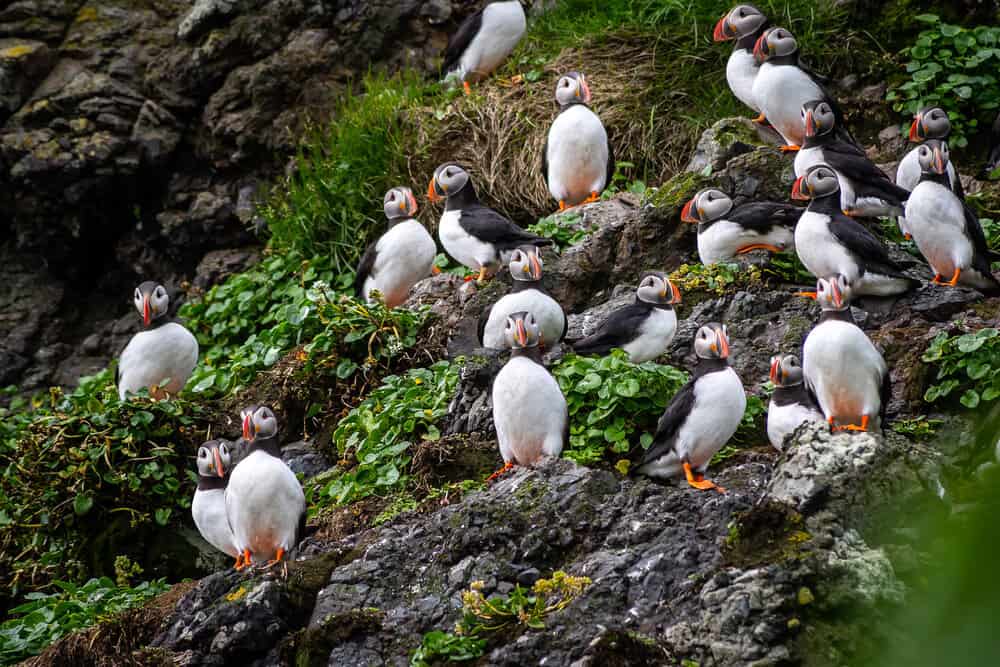
I will leave it up to educated biologists working for the Icelandic Environment Agency to determine the future of puffin hunting in Iceland, just as they do with any other species. They base their evaluations on scientific research, counting, and harvest returns. Through this data, they can quickly determine any changes from the usual trend. Hunters actively participate in gathering data for biological research, providing wings, skulls and other specimens needed to conduct studies. With evidence-based science, the environment agency and ministry issue the yearly hunting quota, season lengths, and restrictions.
Bird watchers, nature conservationists, tourism companies, hunters, and landowners all enjoy mutual benefit from the healthy population of all species. Having a game animal temporarily or permanently removed from the list of huntable species is always tragic. It should be in everyone’s interest to work toward a joint goal: for these species to be hunted on the back of a population recovery.
Recent studies of other bird populations in Iceland have proven that responsible hunting barely plays a role in the equation, with the implications of weather, habitat, and food resource changes of far greater concern. A future where hunting continues will have to account for the complex web of these effects, many of which are driven by climate change.
It might not be too late to change our current, globally destructive path. It is my genuine hope that we will alter our ways, and focus on returning to a time where we give as much as we take from the land and sea. If not for us, then for our children and their children; they will need the wild animals that also call this planet their home, more than we are able to comprehend at the present time. It is my hope to keep these traditions alive for generations to come, so that we Icelanders, as well as many other cultures around the world, can remain connected to our unique heritage as we always have.
